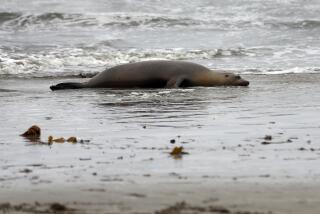Mystery goo: Scientists closer to solving deadly puzzle
Scientists are a step closer to identifying a mysterious gooey substance that has coated and killed scores of sea birds in the San Francisco Bay Area.
The so-called mystery goo, gray in appearance with a feeling like rubber cement, contains a mixture of non-petroleum-based fats or oils, according to the California Department of Fish and Wildlife.
The birds that were covered in the gummy contaminant were unable to keep warm, stay afloat, forage for food or fly.
“This was like a giant jigsaw puzzle with thousands of pieces to put together,” said Janna Rinderneck, an environmental scientist with the California Office of Spill Prevention and Response.
“We had many possibilities of what this material could be. Working together, the laboratories have narrowed that list.”
Officials tested the contaminant and determined it was not toxic, poisonous or harmful to humans. But it took a heavy toll on area birds.
Hundreds were covered with the goo beginning around Jan. 16 in the waters of San Francisco’s East Bay, from Fremont to Alameda Island next to Oakland. Volunteers with the International Bird Rescue cared for 323 birds, but another 170 birds were found dead.
The rescue group reported that 110 birds died in care or on arrival. But the exact number of affected by the gunk may never be known because some birds may have become prey and dead animals may have sunk or been missed during searches.
No new contaminated birds have been found since mid-January.
By narrowing the type of substance to non-petrolem-based fats or oils, scientists know that the contaminant could include synthetic oils such as tung oils or silicon fluids, and wood-derivative oils such as rosin and resin oils. Inedible plant-seed oils as well as animal fats and oils also are among the possibilities.
The oily, sticky substance proved difficult to remove from birds’ feathers.
To clean the birds, volunteers soaked them in vinegar and baking soda and then used dishwashing soap.
More than 100 birds have been released into the wild after cleaning and care. The birds include surf scoters, dunlins, Western sandpipers and eared grebes.
Scientists continue to try to identify the source of the contaminant and perform necropsies on birds that died to find genetic signatures of the substance.
For breaking news in California, follow @VeronicaRochaLA
More to Read
Sign up for Essential California
The most important California stories and recommendations in your inbox every morning.
You may occasionally receive promotional content from the Los Angeles Times.









